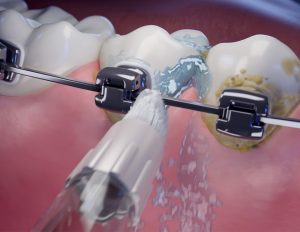 Author: Sharon Kidd GDC – 4566 Diploma in Dental Hygiene 1993 Hygienist
Author: Sharon Kidd GDC – 4566 Diploma in Dental Hygiene 1993 Hygienist
 Orthodontic treatment, spanning from fixed braces to clear aligners, is increasingly common in both adolescents and adults. Of course, this solution for aligning teeth and improving oral function is both appreciated and utilised globally, but with this greatness comes challenges. Daily oral hygiene is significantly more difficult to attain when undergoing orthodontic treatment, particularly interdental cleaning.
Orthodontic treatment, spanning from fixed braces to clear aligners, is increasingly common in both adolescents and adults. Of course, this solution for aligning teeth and improving oral function is both appreciated and utilised globally, but with this greatness comes challenges. Daily oral hygiene is significantly more difficult to attain when undergoing orthodontic treatment, particularly interdental cleaning.
This step in the oral hygiene routine is integral when undergoing any type of dental treatment, but it is significantly more difficult for patients with orthodontic appliances that obstruct access to residual food particles and bacteria. These patients are significantly more susceptible to plaque build-up and hence, gingival inflammation and enamel erosion. Without the correct oral hygiene protocol for those with fixed appliances, the process towards a better smile could become compromised entirely. Proper tools and cleaning habits can assist in deterring these problems, ensuring oral hygiene throughout the orthodontic journey.
Why a better smile requires better cleaning
The design of orthodontic appliances means that brackets, wires, and other addons like bands, permit food debris, and subsequently, bacteria to accumulate.[i] Fixed braces especially, cause even greater inhibitions surrounding everyday cleaning, and standard toothbrushes and floss are often inadequate. Other specific patients that can fall victim to difficulty in oral hygiene are those that wear clear aligners. Aligners are renowned for trapping bacteria, saliva, and food remnants against the enamel and interdentally.[ii] Due to this, excellent oral hygiene must be promoted during aligner treatment.
A common complication with poor dental hygiene during orthodontic treatments is white spot lesions (WSLs) which is the first indicator of enamel demineralisation.[iii] Not only do these spots look aesthetically unappealing, but they also signal early decay. Research surrounding the matter evidences that 38% of patients develop WSLs within six months of beginning orthodontic treatment, caused primarily by poor oral hygiene.[iv] WSLs can become irreversible without professional intervention, and again compromise the whole purpose of orthodontic treatment. [v]
Furthermore, the chances of these patients experiencing gingivitis and bleeding increases due to greater difficulty in flossing with fixed braces and lack of awareness with clear aligners. Orthodontic treatment can be a long commitment, and with additional oral complications, patients could feel demotivated and more self-conscious. This can potentially lead to avoidance of appointments and vicious cycles regarding their relationship with oral care.
Why traditional floss often falls short
Traditional floss is certainly adequate when used properly, and in the right circumstances. However, the structure of fixed braces, with wires and brackets, make this a challenging task that requires time and nimbleness.[vi] With removable aligners, regular floss is recommended and sufficient, though challenges in establishing and maintaining new dental hygiene habits with the addition of orthodontic treatment remain.
Due to both these circumstances respectively, flossing can be avoided or performed inadequately, allowing opportunity for food particles and bacteria to be retained interdentally, and eventually lead to plaque build-up and decay. Fortunately, other options are available for those undergoing orthodontic treatment, who require nimbler, more appropriate tools for the task.[vii] These products are particularly useful for fixed appliance users, but additionally for all those seeking a worthy interdental cleaning routine.

Finding the perfect partner for the future of your hygiene
For any patient seeking great interdental hygiene, and particularly orthodontic patients, interdental flossing is a great option. Water flossers are another excellent method of cleaning interdentally. For fixed brace users, their speed and ease of use make no other option more efficient.[viii] For aligner wearers, who are constantly removing and reinserting their mouthpiece throughout the day, water flossing is a great way to add a refreshing clean between meals and an impactful addition to anyone’s oral hygiene routine.
When choosing which water flosser to purchase, look no further than Waterpik™ – the #1 water flosser brand recommended by dental professionals.[ix] The Cordless Plus by Waterpik™is clinically shown to be up to 3x as effective for removing plaque around braces versus brushing and string flossing when used with the innovatively designed Orthodontic Tip, specific for targeting those hard-to-reach areas. With the extra quiet design, minimised size, and portability, the WaterpikTM water flosser is the perfect accomplice in challenging harboured food remnants right after eating – perfect for clear aligner wearers on-the-go and fixed brace wearers, wherever they need it.
The benefits of interdental cleaning whilst undergoing orthodontic treatment extends far beyond clean teeth. Maintaining good interdental health is integral for preventing long-term complications and ensuring that the outcome of treatment is a straight and healthy smile.

For more information on WaterpikTM water flosser products visit www.waterpik.co.uk. WaterpikTM products are available from Amazon, Costco UK, Argos, Boots and Tesco online and in stores across the UK and Ireland.
Recommend by brand
[i] Madariaga, Ada & Bucci, Rosaria & Rongo, Roberto & Simeon, Vittorio & D’Antò, Vincenzo & Valletta, Rossella. (2020). Impact of Fixed Orthodontic Appliance and Clear Aligners on the Periodontal Health: A Prospective Clinical Study. Dentistry Journal. 8. 4. 10.3390/dj8010004.
[ii] Yadav, Pramod & Verma, Sanjeev & Bais, Deepika & Singh, Shriya. (2024). Impact of clear aligners on plaque and periodontal health. International Journal of Oral Health Dentistry. 10. 9-12. 10.18231/j.ijohd.2024.002.
[iii] Rouzi, M., Zhang, X., Jiang, Q., Long, H., Lai, W., & Li, X. (2023). Impact of clear aligners on oral health and oral microbiome during orthodontic treatment. international dental journal, 73(5), 603-611
[iv] Tufekci, E., Dixon, J. S., Gunsolley, J. C., & Lindauer, S. J. (2011). Prevalence of white spot lesions during orthodontic treatment with fixed appliances. The Angle orthodontist, 81(2), 206–210. https://doi.org/10.2319/051710-262.1
[v] Shankarappa, S., Burk, J. T., Subbaiah, P., Rao, R. N., & Doddawad, V. G. (2024). White spot lesions in fixed orthodontic treatment: Etiology, pathophysiology, diagnosis, treatment, and future research perspectives. Journal of orthodontic science, 13, 21. https://doi.org/10.4103/jos.jos_205_23
[vi] AlMoharib, H.S., Alqasem, A., Almusfer, G. et al. The effectiveness of water jet flossing and interdental flossing for oral hygiene in orthodontic patients with fixed appliances: a randomized clinical trial. BMC Oral Health 24, 498 (2024). https://doi.org/10.1186/s12903-024-04166-0
[vii] Imai, Pauline & Yu, Xiaoli & Macdonald, David. (2012). Comparison of interdental brush to dental floss for reduction of clinical parameters of periodontal disease: A systematic review. Can J Dental Hygiene. 46.
[viii] Mohapatra, S., Rajpurohit, L., Mohandas, R., & Patil, S. (2023). Comparing the effectiveness of water flosser and dental floss in plaque reduction among adults: A systematic review. Journal of Indian Society of Periodontology, 27(6), 559–567. https://doi.org/10.4103/jisp.jisp_597_22
[ix] Based on 2025 independent survey of Dental Professionals; among those who recommended branded water flossers.




